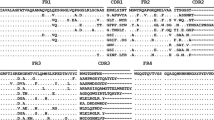Summary
Polyclonal murine antibodies that recognize the adducts formed by benzene metabolites in hemoglobin (Hb) were prepared and used to develop immunoassays. In competitive inhibition assays, the concentration of competitor needed to reduce the signal by 50% (IC50) was less than 10 pmoles for hydroquinone-hemoglobin (HQHb) adducts and less than 1 pmole for 1,2,4 trihydroxybenzene-hemoglobin (TriOH Hb). Hemoglobin (Hb) incubated with either phenol or catechol (CAT) did not elicit antibodies suitable for quantitative immunoassays. The metabolite-directed immunoassays were tested using hemoglobin from mice previously administered [C14] benzene for two to four weeks. The most sensitive assay for hydroquinone measured 0.49 pmoles adduct/40 pmoles Hb (191 pmoles adduct/mg Hb) in mice treated with 200 mg/kg benzene (P < 0.05, Student's t test). TriOH Hb adducts were not detected.
Similar content being viewed by others
References
Adams, WJ, Biemann, K (1990) Tandem mass spectrometry of human hemoglobin adducts formed by in vitro reaction of 1,4 benzoquinone with erythrocytes. The 38th ASMS Conference on Mass Spectrometry and Allied Topics. pp. 337–338
American Conference of Governmental Industrial Hygienists (ACGIH) (1988) Documentation of Threshold Limit Values
Au WW, Ramanujan WMS, Ward JB Jr, Legator MS (1991) Chromosome aberrations in lymphocytes of mice after sub-acute low-level inhalation exposure to benzene. Mutat Res 260:219–224
Bechtold WE Sun JD, Birnbaum LS, Yin SN, Li GL Kasicki S, Lucier G, Henderson RF (1992) S-phyenylcysteine formation in hemoglobin as a biological exposure index to benzene. Arch Toxicol 66: 303–309
Berlin, M (1992) Low level benzene exposure in Sweden: Effect on blood elements and body burden of benzene. Am J Ind Med 7:365–373
Fishbein L (1984) An overview of environmental and toxicological aspects of aromatic hydrocarbons. I. Benzene. Sci Total Environ 40:189–218
Gan LS, Skipper PL, Peng S, Groopman JD, Chen J, Wogan GN, Tannenbaum SR (1988) Serum albumin adducts in the molecular epidemiology of anatoxin carcinogenesis: correlation with anatoxin BI intake and urinary excretion of anatoxin Ml. Carcinogenesis 9:1323–1325
Goldstein BD (1977) Benzene Toxicity: A critical evaluation; Hematotoxicity in humans. J Toxicol Environ Health Suppl 2: 69–105
Harris CC, Vahakangas K, Newman MJ, Trivers GE, Shamsuddin A, Sinpoli, N, Mann DL Wright WE (1987) Detection of benzo(a)pyrene diol epoxide-DNA adduct in peripheral blood lymphocytes and antibodies to the adducts in serum from coke oven workers. PNAS USA 82:6672–6676.
Hattemer-Frey HA Travis CC, Land ML (1990) Benzene: Environmental partitioning and human exposure. Env Res 53: 221–232.
Henderson RF, Sabourin PJ, Bechtold WE, Griffith WC, Muddiness MA Birnbaum LS, Lucier GW (1989) The effect of dose, dose rate, route of administration, and species on tissue and blood levels of benzene metabolites. Environ Health Persp 82:9–17.
Infante PF (1992) Benzene and leukemia: The 0.1 ppm ACGIH proposed threshold limit value for benzene. Appl Occup Environ Hyg 7:253–262.
Inoue O, Seiji K, Nakatsuka H, Watanabe T, Yin SN, Li GL, Cai SX, Jin C, Ikeda M (1989) Determination of catechol and quinol in the urine of workers exposed to benzene. Br J Ind Med 45: 487–492.
Inoue O, Seiji K, Nakatsuka H, Watanabe T, Yin SN, Li GL, Cai SX, Jin C, Ikeda M (1989) Excretion of 1,2,4-benzenetriol in the urine of workers exposed to benzene. Br J Ind Med 46: 559–565.
Keller KA, Snyder CA (1988) Mice exposed in utero to 20 ppm benzene exhibit altered numbers of recognizable hematopoietic cells up to seven weeks after exposure. Fund Appl Toxicol 10: 224–232.
Pereira MA, Chang LW (1981) Binding of chemical carcinogens and mutagens to rat hemoglobin. Chem Biol Interact 33: 301–305.
Roberts DW, Pumford NR, Potter DW, Benson RW, Hinson JA (1987) A sensitive immunochemical assay for acetaminophen-protein adducts. Pharmacol Exp Therap 241: 527–533.
Sabourin PJ, Sun JD, MacGregor JT, Wehr CM, Birnbaum LS, Lucier G, Henderson RF (1990) Effect of repeated benzene inhalation exposures on benzene metabolism, binding to hemoglobin and induction of micronuclei. Toxicol Appl Pharmacol 103: 452–462
Sawahata T, Neal RA (1983) Biotransformation of phenol to hydroquinone and catechol by rat liver microsomes. Molec Pharmacol 23: 453–460.
Tentori L, Sakat AM (1981) Hemoglobinemetry. Methods in Enzymology 76: 707–715.
Author information
Authors and Affiliations
Rights and permissions
About this article
Cite this article
Grassman, J., Haas, R. Development of an immunoassay to detect hemoglobin adducts formed by benzene exposure. Int. Arch Occup Environ Heath 65 (Suppl 1), S147–S150 (1993). https://doi.org/10.1007/BF00381328
Issue Date:
DOI: https://doi.org/10.1007/BF00381328




